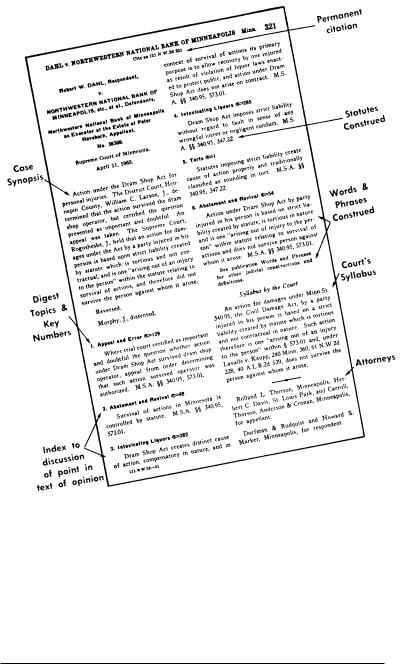
Daniel Oran - Oran's Dictionary of the Law
.pdf
558 Appendix C
Finally, update your research with information from any pocket parts, supplements, or binders of slip laws available, and don’t forget to determine each statute’s current validity using a citator.
State Administrative Regulations and Local Ordinances
These lower-level sources of law are not always collected in one place. Their organization, style, and quality vary widely. Regulations and ordinances are often highly detailed, and at the same time vague, and they sometimes conflict with the state laws that authorized them. Persistence and care are needed to track them down and to understand them.
There are four general approaches to finding this material. First, you can check on-line, as WESTLAW and LEXIS regularly add more of this information, and some is available in bits and pieces on the World Wide Web. (See Computer-Assisted Legal Research for more information.) Second, you can check to see if your library collects it in one place. Third, you can e-mail, write, call, or visit the agency, department, or city government in question. And fourth, you can search the secondary sources (Shepard’s state and ordinance law citators, A.L.R., digests, articles, looseleaf services, etc.). These are described starting on page 566–567.
Caselaw: The National Reporter System (NRS)
What Is in It? Only about one percent of the cases decided by courts in the U.S. have been collected and printed, but there are well over a million cases now in books. Most of these cases are in the books of the National Reporter System (NRS), West Group. State appellate court cases considered important enough to publish are in one of the regional reporters and cases from federal courts are in one of the federal court reporters (such as the Supreme Court Reporter). For example, one of the regional reporters, the Southern Reporter, contains cases from Alabama, Florida, Louisiana, and Mississippi. Each individual book of a reporter is called a volume, and cases in each reporter are in rough chronological order. Figure 5 summarizes the NRS. The National Reporter System is on WESTLAW, which makes it far easier to use than the equivalent paper volumes. It is also on CD-ROM.
How Do You Use It? The location of a case within the National Reporter System is given by an abbreviation known as a citation (“cite” for short). For example, the citation “121 N.W.2d 321” gives the location of a case in the 121st volume of the North Western Reporter, Second Series on page 321.
Cases are sometimes published in the NRS and in reporters put out by other publishers or by the states themselves. Only one of these publications is the official one; sometimes it is the NRS. When you have one


560 Appendix C
FEDERAL |
|
|
REPORTERS |
BEGINNING |
COVERAGE |
Federal Supplement |
1932 |
United States Court of Claims from |
|
|
1932 to 1960; United States District |
|
|
Courts since 1932; United States |
|
|
Customs Court from 1956 to 1980; |
|
|
Court of International Trade from |
|
|
1980; Judicial Panel on Multidistrict |
|
|
Litigation from 1968; and the |
|
|
Special Court, Regional Railroad |
|
|
Reorganization Act from 1973 |
Federal Rules |
1939 |
United States District Courts |
Decisions |
|
involving the Federal Rules of Civil |
|
|
Procedure since 1939 and the |
|
|
Federal Rules of Criminal Procedure |
|
|
since 1946 |
Supreme Court |
1882 |
U.S. Supreme Court beginning with |
Reporter |
|
the October term of 1882 |
Bankruptcy |
|
|
Reporter |
1980 |
Bankruptcy decisions of U.S. |
|
|
Bankruptcy Courts, U.S. District |
|
|
Courts, U.S. Courts of Appeals and |
|
|
the U.S. Supreme Court |
Military Justice |
1978 |
United States Court of Military |
Reporter |
|
Appeals and Courts of Military |
|
|
Review for the Army, Navy, Air |
|
|
Force and Coast Guard |
United States |
1982 |
United States Court of Federal |
Federal Claims |
|
Claims decisions beginning |
Reporter |
|
October 1982 |
|
|
|
Figure 5 ■ National Reporter System (continued)
citation to a case, you can find the other (if it exists) by using tables in the
National Reporter Blue Book or by using the appropriate citator.
Each individual volume in the NRS has reference material about the cases in the volume. For example, each has a Table of Cases Reported (a list of cases by court system); a Table of Statutes Construed (a list of statutes discussed in the various cases in the volume); a Table of Words and Phrases (a list of important words and phrases defined in the cases);


562 Appendix C
Caselaw: Other Sources
Non-NRS Federal Reporters. The official reporter for decisions of the U.S. Supreme Court is called United States Reports. A frequently used annotated version is United States Supreme Court Reports, Lawyer’s Edition (LEXIS Publishing). It is known simply as “Lawyer’s Edition” (L.Ed.). Some volumes contain the briefs in the case. It is also available on-line from LEXIS.
Two looseleaf services print weekly copies of Supreme Court decisions. These are the Supreme Court Bulletin (Commerce Clearing House) and United States Law Week (Bureau of National Affairs). Law Week is more frequently used because of its news coverage of other legal matters. All other collected reports of federal court cases are in the National Reporter System.
Other State Reporters
As mentioned before, some states have official reporters that are not part of the National Reporter System.
Secondary Sources
Martindale-Hubbell
What Is in It? The first volumes of the Martindale-Hubbell Law Directory contain a state-by-state listing of practicing lawyers and law firms. Unless you need this information, go right to the Digest volumes. They contain summaries of the law of each state by legal topic with examples of legal forms needed for many topics. They also contain copies of uniform and model acts, short summaries of the law of almost every foreign country, and reviews of federal copyright, patent, and trademark law. MartindaleHubbell is available in book form, on LEXIS, and on the World Wide Web under its name.
How Do You Use It? Martindale-Hubbell is not hard to use. It has a topical index with good cross-referencing to find the right subject areas. These subjects are the same for each state and include all the areas of everyday law. Each state has a smaller index and an explanation of what its citations and abbreviations mean. There are, however, a few things to keep in mind. First, even though Martindale-Hubbell is updated frequently, there is still the chance that state law has changed. Second, it is very condensed, so you may be missing some of the fine points of the law. And third, it is not an authoritative source. It is useful for quick, preliminary answers to many legal questions, but should not be cited.

Legal Research 563
Key Number Digests
What Is in Them? Key Number Digests have been called one of the four pillars of legal research. (The other three are the ALR Annotations, Shepard’s Citators, and computer-assisted research.) Key Number Digests are a comprehensive method of categorizing, indexing, and finding the legal subjects discussed in U.S. courtrooms.
A Key Number is a permanent number given by West Group to a specific legal subject as categorized by West. It is usually preceded by the Key Number symbol  . West first subdivided all possible legal subjects into seven main headings, then broke these headings into thirty-two subdivisions and approximately four hundred “Key Number topics.” Figure 7 on page 564 is a part of that breakdown. Finally, each of these Key Number topics is broken down into many Key Numbers unique to each Key topic. The Key Numbers in each Key Number topic do not correspond to those in other Key Number topics, so you must know both the topic and the Key Number. New Key Numbers are added to topics regularly, and old ones are further and further subdivided.
. West first subdivided all possible legal subjects into seven main headings, then broke these headings into thirty-two subdivisions and approximately four hundred “Key Number topics.” Figure 7 on page 564 is a part of that breakdown. Finally, each of these Key Number topics is broken down into many Key Numbers unique to each Key topic. The Key Numbers in each Key Number topic do not correspond to those in other Key Number topics, so you must know both the topic and the Key Number. New Key Numbers are added to topics regularly, and old ones are further and further subdivided.
A West editor who reads a case that comes into the National Reporter System picks out each legal point and writes a brief summary of that point in a single paragraph. These paragraphs are given a topic and Key Number, are printed with decisions in case reporters (see Figure 6 on page 561), and are collected into Key Number Digests by topic and Key Number.
There are Key Number Digests for most individual state reporters, for most regional reporters, most United States court reporters, and for specific subjects (such as bankruptcy and education). The material in all these digests is then collected into the American Digest, a massive master index of caselaw summaries covering the whole country and most of its appeals courts since colonial days. The American Digest is divided into a Century Digest (1658–1896), a series of Decennial Digests (1897–1905, 1906–1915, etc.), General Digests (yearly between the last and the next Decennial), and updating pamphlets.
How Do You Use Them? Key Number Digests are available in paper and
CD-ROM form and on-line through WESTLAW. For computer-assisted use, first read the following general information, then go to page 573. All the
Key Number Digests (except the Century Digest, which predates the Key System) work exactly the same way. If you want to know about “Theaters and Shows  6(18) athletic events” in Florida only, use the Florida Key Digest; for “Theaters and Shows
6(18) athletic events” in Florida only, use the Florida Key Digest; for “Theaters and Shows  6(18) athletic events”; in the whole Southern region, use the Southern Key Digest; do the same for federal courts and the Supreme Court. For the whole country, use the American Digest.
6(18) athletic events”; in the whole Southern region, use the Southern Key Digest; do the same for federal courts and the Supreme Court. For the whole country, use the American Digest.


Legal Research 565
The most direct way into the Key Numbers is to start with a case that discusses the question that you want to answer. Few researchers are so lucky, but if you do have a printed case on point, you can go straight from the case’s Key Number summary paragraphs to a digest. If all you have is a case name, you can look it up in the Table of Cases for the digest you want to use. This will give you, in addition to more information about the case, the Key Numbers that summarize its legal points.
A Descriptive Word Index is the best way into the digests. You start by categorizing your problem and generating an expanded list of related words using the “Cartwheel” method explained earlier or your own method of adding search words with the help of this dictionary. You then look up these new words alphabetically in each digest’s Descriptive Word Index. Those that exist in the index will lead you to topics and Key Numbers. Once you find the Key Numbers you need, look them up in the digest.
It may take a long time to wade through the summary paragraphs. If you are working with the American Digest (rather than with one of the regional, state, or U.S. court digests), you may sometimes need to consult every digest in the system, plus the updates. (Be sure to see the Cumulative Table of Key Numbers to avoid having to look through every General Digest.) Only use the American Digest approach if you have no quicker alternative using a digest for a smaller geographical area or more limited range of subjects.
Finally, do not rely completely on the Key Number Digest paragraphs because they are overly condensed and sometimes misleading. Read the case referred to for what the judge really said. And never cite the summary as authority for a legal point. It isn’t.
American Law Reports (A.L.R.)
The book version of A.L.R. is a complex law finder, but it is worth mastering because, if you find what you need, it comes in highly concentrated form. The on-line version is much easier to use. It operates the same way as, and is integrated with, the rest of the WESTLAW search system (National Reporter System, U.S.C.A., Key-Cite, etc.). See “How to Use” on page 575.
What Is in It? A.L.R. has hundreds of volumes, each containing several selected “lead” cases (some with summaries of the briefs and decision in addition to the full opinion). Each case is followed by a long annotation.
Each annotation refers to hundreds of other cases based on the same area of the law from various jurisdictions. The lead case is a way of pulling together the “core” of a legal subject area, such as “product liability: heating equipment.” The other cases provide greater detail and take the subject

566 Appendix C
into related fields. In this respect, A.L.R. (with its various indexes and digests) is a combination of case reporter, digest, and encyclopedia. It is cross-referenced with the American Jurisprudence (Am. Jur.) encyclopedia and many other West Group publications.
Recent A.L.R. volumes begin each annotation with sections called scope (what is covered generally), related matters (where to look for related topics not covered), summary (a brief review of the legal concepts), practice pointers (a list of information on pleading, evidence, and tactics), and an index of points covered. The bulk of the annotation is a detailed discussion of the caselaw with complete statutory and other references.
How Do You Use It? American Law Reports includes the following series of books: A.L.R. (state and federal cases from 1919–1948), A.L.R. 2d (state and federal 1948–1965), A.L.R. 3d (state and federal 1965–1969, state only 1969–1980), A.L.R. 4th (state only, 1980–1990), A.L.R. 5th (state only 1990 on) and A.L.R. Federal (federal only, 1969 on). Volumes are updated on different schedules.
You will occasionally be referred directly from a citator, treatise, or encyclopedia to the one A.L.R. lead case that gives you everything you need. Otherwise, start by using the Index to Annotations (which cumulates individual indexes to A.L.R. 2d, 3d, 4th, 5th, and Federal ). It classifies thousands of topics legally and factually.
The Index also has a table of statutes and regulations cited, a “history table” that shows how each annotation has been updated or replaced, and pocket parts that must be checked for the most recent entries in A.L.R. 5th and Federal. If the Index yields no results, you can try the Digest, which classifies annotations in A.L.R. 3d, 4th, 5th, and Federal into a few hundred legal topics.
Finally, once you have material you need, make sure to update it by checking separate volumes called Later Case Service for A.L.R. 2d, and by checking the pocket parts in each volume of A.L.R. 3d, 4th, 5th, and Federal. This can be crucial. Also, A.L.R. is still growing, with new indexes and services coming out all the time.
Citators: Shepard’s, KeyCite, etc.
What Are They? A citator is a set of books or a computerized database used to determine the current validity of a legal authority (such as a case, statute, regulation, or law review article) by listing the places that it has been cited (mentioned). Citators are a good way to find relevant authority and are the only way to validate your research. Citators confirm that the statutes you quote are still in force and unchanged, that the cases you rely on are still good precedent and the best available to prove your point, and

Legal Research 567
that you have found the most relevant material. You should never formally use a case, statute, or other authority without validating it with a citator.
On a complex, time-consuming project, you probably shouldn’t even bother to take notes on a long case without cite-checking it first.
Until recently, all comprehensive legal citators came printed on paper from Shepard’s, so all cite-checking was called Shepardizing. Shepardizing involves reading tiny symbols with exhausting care to follow long citation trails though countless books and supplementary pamphlets. Computerized cite-checking has lightened this burden greatly for those with access to use it. This appendix uses Shepardizing a case to illustrate paper-based cite-checking (Shepards is also available on CD-ROM and online through LEXIS), and uses KeyCite to describe computerized citechecking (KeyCite is available on CD-ROM and through WESTLAW).
Shepardizing a Case through Books and Pamphlets. A typical listing under a case in a Shepard’s citator will give parallel citations (other places the same case has been printed), the history of the case (has it been appealed, overruled, etc.?), the treatment of the case (other cases where it has been followed, distinguished, or otherwise mentioned), and a list of the law journal articles, annotations, etc. that have analyzed or mentioned the case.
A typical “simple” Shepardizing might go like this: You find Case A, which is very similar to your research problem and says exactly what you want to hear (good). You Shepardize that case and find that it was not overruled (good), was followed in two later cases (good), and was distinguished in three later cases (bad). You read and Shepardize the cases that followed Case A and find nothing useful (bad). You read and Shepardize the cases that distinguished Case A and find that two of them are very different from your original research problem and, besides, nobody else mentions them (good). But the third, Case B, is very similar (bad). You Shepardize Case B and find that it was overruled (good). You have a case worth citing.
Here is how to deal with the books: A set of Shepard’s citators may cover more than one set of case reporters, so you may have to look around a bit. First, make sure that you have found a complete set of citator main volumes and supplements. You do this by getting the latest pamphlet (usually no more than a month old) and reading the box on the cover, which lists all volumes and supplements in current use. If your set is incomplete, your research is suspect and, perhaps, worthless.
Second, use all the volumes and check each one carefully for citations. Continue tracking down each chain of citations until you come to the end. Shepardizing is repetitive, so it’s easy to accidently skip a crucial book, flip past a crucial page, or skim by a crucial cite. Be methodical. Also,
